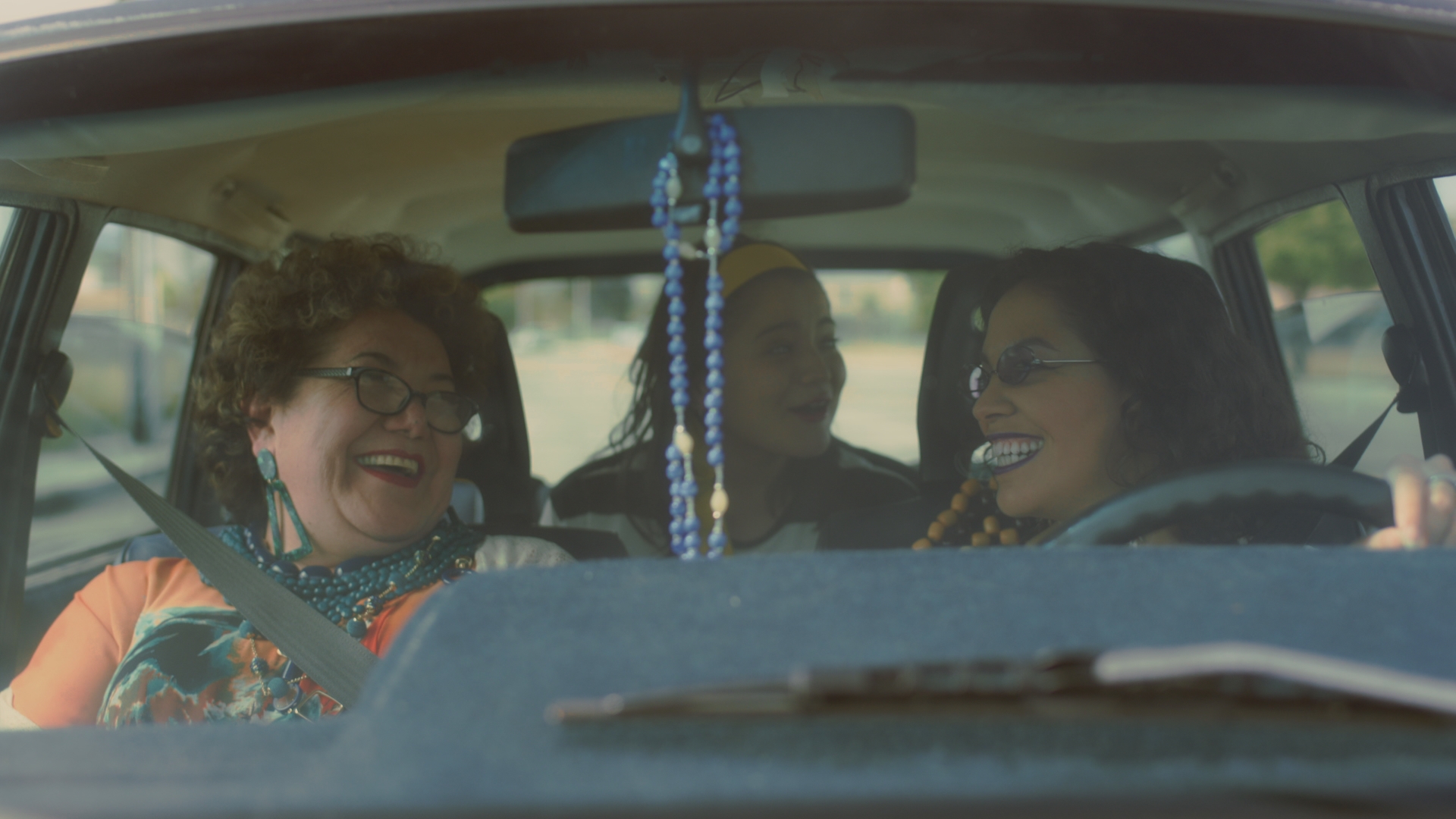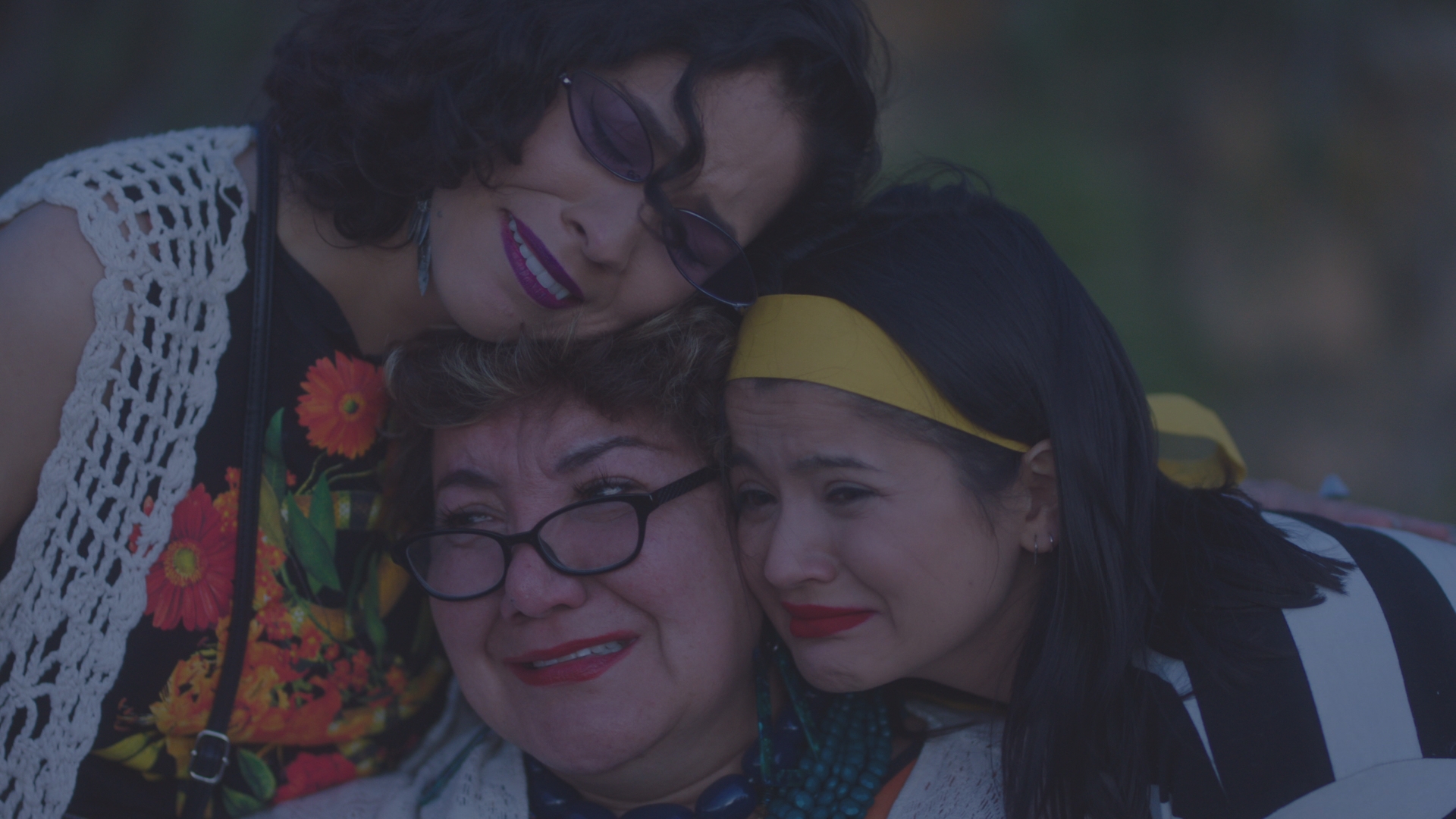In the first few seconds of the short film Joyride, sisters Karina (Stacey Patino) and Marina (Jenny Trevino) prepare for somewhat of an atypical road trip. They’re about to break their grandmother Juana (Blanca Araceli) out of her nursing home and drive her across state lines to the Grand Canyon.
The three of them laugh and joke on the way but as they approach their destination, Juana opens up about secrets she’s been carrying for decades. The film becomes an intimate portrait of intergenerational trauma, domestic violence, and the love between grandmothers and their grandchildren—all in less than 14 minutes.
Joyride, written and directed by the queer Nicaraguan-American filmmaker Edwin Alexis Gómez and presented by Latino Public Broadcasting, was put together by an almost entirely Latinx team, which included Latina producers Angela Pedraza and Evelyn Angelica Martinez, and executive producer and editor J.R. Arinaga. Gómez drew on experiences from his own family, as well as years spent working as a domestic violence advocate, to craft the emotional narrative. When the film competed in this year’s PBS Short Film Festival, viewers quickly fell in love with Juana and voted Joyride the festival’s “most popular” entry—something Gómez says he didn’t quite see coming.
“To be honest, I was very surprised,” he tells Remezcla. “For me as a filmmaker, and for the team, this wasn’t something we did for prizes or accolades. We poured ourselves into the love of the craft and we thought a lot about the ways in which the industry says that certain stories are not universal. What this showed me was that when you write, direct, produce, and make anything from the heart that is rooted in your own life, it will resonate.”
Now, Gómez is working on expanding the short film into a full-length feature for 2022. As he tells more of Juana’s story, he hopes that other people will connect with the themes in her life and open up to their loved ones if they want to share their own experiences. Gómez spoke to Remezcla about the inspiration behind the film, his plans for the story, and the importance of getting Central American voices on screen.
What inspired Joyride and how did you first come up with the idea for the short film?
My mom passed away maybe about four and a half, five years ago, and I had stopped writing completely for about two or three years. I think that cemented this theme that I was dealing with, which was this idea of emotional inheritance, and the things that we inherit from family. The inspiration was actually a road trip that I took with my mother to San Francisco about a year before she passed, and that was compounded with memories of my grandmother when she was alive. I was thinking about conversations I’d had with my mother and my grandmother growing up and the way that the matriarchs of families live so much and have so much to offer if you listen.
I wanted to write about this journey, and I didn’t really know what these characters were embarking on until I was writing. And then, I realized that this was a story about letting go, about domestic violence, and about reminding future generations of what mistakes not to make in their lives.

The film says so much not only about intergenerational trauma, but also just how we’re shaped and loved by the people who came before us, especially through the character of Juana. How did Juana come to you and what was it like to write that character?
So Juana, actually, was the name of my grandmother, so there was a lot from both my mother and my grandmother projected onto Juana. I think Juana specifically embodies the Latina that is always looking towards optimism, toward being the life of the party, towards being someone who makes people laugh, even though they’ve had so much personal tragedy. My whole family is from Nicaragua, so growing up and listening to things about life in the Somoza dictatorship and trying to push for freedom. All of that led to this micro-theme of ‘a revolution of one’ and questions of ‘how do you push against the forces that are keeping you from freedom, that are pulling you away from the life that you imagine living?’ In many ways, Juana was the apex of all of those themes.
I also spent a good seven and a half, eight years being a domestic violence advocate. I worked the graveyard shift at a domestic violence advocacy organization and, in many ways, the men, women, and children that I worked with were such a mirror of the stories my family told from their own lives. I was able to help a lot of Latin Americans of different statuses, undocumented to American citizens, navigate their trauma and the domestic violence that was lived in a similar way to my family, considering our personal histories. So, for me, Juana was this light that was created from all of those different sources.
The film transitions seamlessly from the bliss and the freedom these girls feel while enjoying this joyride with their grandmother to getting into the grief and trauma that she’s been through. Tell me a little bit about striking that balance and getting that emotional complexity in the story.
That was one of my favorite things to play with as a writer and director because I felt like it’s true to life when you’re on a road trip. You have these moments where you’re laughing with each other and a certain song comes on and something hits emotionally where suddenly a family member is crying and you get into what the song reminds them of. It’s like a whole divulging of a secret history. There’s something special with this small environment in a car—I feel like cars are a really great place for intimacy.
Juana left the nursing home knowing she was going to tell her granddaughters her story, but I think she didn’t know how she was going to bring it up. And so in a way, it’s the inquiry as well, of Karina, saying, ‘Why are we going to the Grand Canyon?’ It actually becomes a way for us to reflect on the questions, the conversations, and just the things we should be asking those who are older in our lives that we sometimes forget when we’re on our phones, or on our laptops, or playing video games. I really wanted to reference how much there’s a lack of connection right now, and how much that human connection means something so vital to all of us. Finding that balance really was kind of a true-to-life pairing of sweetness and bitterness, like the way that a conversation when you know someone so well happens.

The music was done by Y La Bamba, an artist who does such a beautiful job of tracing roots and making contemporary music that feels like it bridges past generations. Tell me about when you realized her sound was right for the film.
When I was writing, I was listening to Y La Bamba. I think Luz Elena Mendoza [the artist behind the project]—just her lyrics, the emotion, the way it almost feels like a faded memory at times with the filtering—it felt so right in the creation of the piece. And so, when really thinking about this film and the aesthetics and how it fit, I had to reach out. I had no idea if it would be possible [to collaborate] because Luz was touring and making music at the time. But luckily, since we’re friends, it worked and it was really a great fit. Also, I was able to bring in one of my great friends Will Munroe, who bridged the songs in different scenes and did an incredible job emulating this whole list of emotions and what is happening internally with characters. Working with Y La Bamba and Will Munroe, I felt like we stitched together a really beautiful narrative that can also be felt through the music. Our sound designer Ricardo Licea balanced and mixed the music of Y La Bamba and the original scores of Will Munroe, uniting the aural aspects of the film.
The film was also strengthened by director of photography Silvia Lara, who masterfully reflected the emotional gravity of the film frame by frame. It was wonderful working with such a talented DP that understood intimately the journeys of these three Latinx women. Our art director Freddy Pelaez captured the bohemian abuelita vibes and color palette that was always the aesthetic I pictured in my mind when developing the script.
You’re turning Joyride into a full-length feature. What might we see about Juana’s journey in an extended version of the film?
One of the things that I felt couldn’t do justice to in the short film was the idea of sexuality and to have someone’s sexuality restrained by culture. I think exploring the nuances of who Juana wanted to be and who she ended up being, alongside with the journey of one of the sisters, is kind of where the feature is going right now. For me, Juana is haunted by domestic violence and letting go of the past, so we’ve been excavating what haunts Karina, what haunts Marina, as well as the generation that isn’t shown in the short film: The sisters’ mother. It’s about seeing the way history plays out from generation to generation and thinking of how the ways in which we live change the way we raise children and the choices were met with. The feature is dealing with all of the nuances of three generations as they make sense of their lives and heal.
You’re the co-founder of Cundina Collective, a production company that focuses on amplifying voices that aren’t often heard in film. Tell us about what it means to you to get Central American perspectives on screen and bring stories that are rooted in your Nicaraguan background to the forefront.
I’ll start by saying that I think Central American voices are critical and they’re often not seen. When I think of Nicaraguans in particular, I also just see all of the history. I see all of the different barriers that had to be transcended—the dictatorship, the revolution, the earthquake, all of those things that we went through as a country and then rebuilding as a nation. But even as someone who is a Nicaraguan-American writer-director, I have never seen a Nicaraguan character. To be honest, for the most part of my writing career so far, I got really nervous to write a Nicaraguan character. I had to really think about it and say, ‘Who is telling Nicaraguan stories specifically? Who is telling Central American stories? What are the narratives we’re seeing?’ And I realized, ‘Oh, man. This is where the work starts.’ We have to start telling nuanced stories.
The more that everyone tells their story, the richer we are in understanding the nuances of culture. We’ve spent a lot of time building bridges and understanding our lives through white characters and white narratives, so it’s about time that that same effort is done the other way around because what we’ll find is that there is a universal human story that we’re crafting. I think any work of art, regardless of who makes it, is kind of always reaching for this universality of what it means to be human and what it means to be alive. I think finding that specific poetic voice that is Central American, that is pulled from the countries we originate from and where our families originate from—that’s going to make all media richer.







